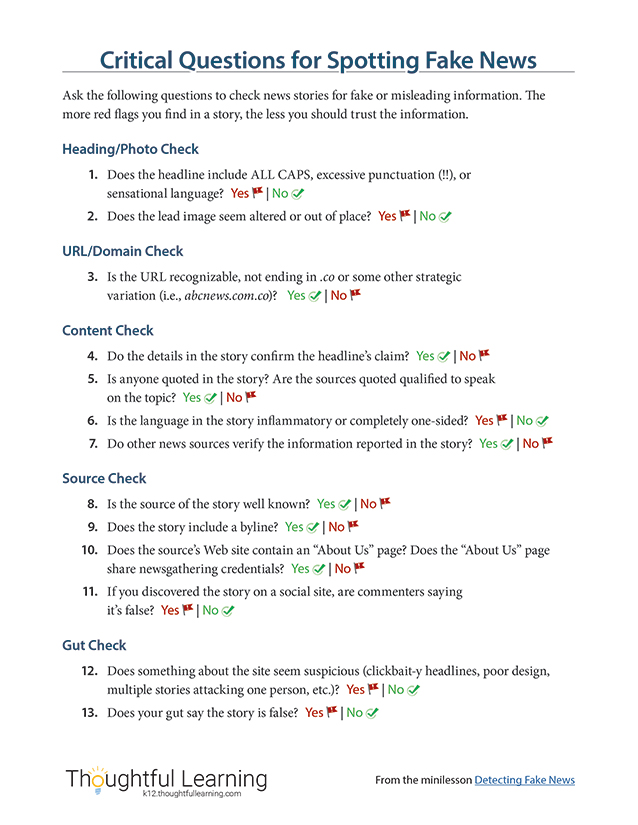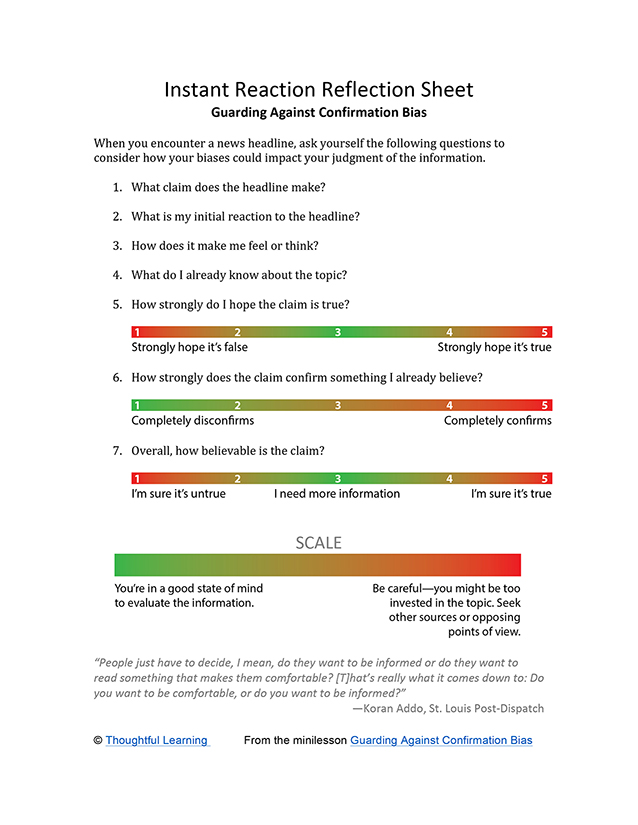
“Truth, crushed to earth, shall rise again,” William Cullen Bryant exclaimed in his Civil War-era poem, “The Battlefield.” Nearly two centuries later, it feels like truth is yet again fighting an uphill battle.
We live at a time when the Oxford Dictionary chooses post-truth as its word of the year. Misleading news stories litter our social-media feeds, and we struggle to distinguish credible sources from bogus ones. This swirl of misinformation fuels distrust of accurate news and enhances our own biases.
If truth truly is to rise again, we need to equip our students (and ourselves) with media-literacy strategies for separating fact from fiction, real news from fake news. We also need to encourage students to speak up when they encounter shady stories to prevent their spread.
The strategies in this post can help our students spot and stop fake news.
Detecting Red Flags
“Fake news” refers to intentionally false, misleading, or salacious stories masquerading as real news. Students are most likely to encounter fake news on social media, where misinformation can be shared widely and rapidly. In fact, in the lead-up to the 2016 presidential election, fake news stories received more engagement on Facebook than the top stories from mainstream news outlets.
Fake news stories may be difficult to distinguish from reliably reported ones, so students must use a critical eye to judge news from their social accounts. Students can ask the following critical questions to help them detect fake stories. (They can practice using the questions in the "Detecting Fake News" minilesson.)

(Click on the image for a larger version)
While mainstream media follow more reliable reporting and editorial practices than most independent sources, they do not always tell the complete truth. Students can apply the same critical questions from above to mainstream news.
In addition to teaching critical questioning, we can encourage students to visit fact-checking sites when they are unsure about the reliability of a source or story. Snopes and FactCheck.org are two good places to start.
Recognizing Our Own Biases
Evidence suggests many social-media users spread fake news not because they think the stories are true, but because the stories confirm their biases. Confirmation bias refers to the tendency to seek and interpret information in ways that affirm something we already believe in. Fake-news writers have a shrewd understanding of bias and purposely choose topics that appeal to the existing beliefs of large swaths of people.
To avoid manipulation, students should reflect on how a story makes them feel when they first encounter it. They should use caution with information that makes them feel overly emotional—for or against the subject. The more invested they are in hoping a story is true or false, the harder it becomes to judge the information fairly or objectively. Students can use the reflection sheet from the "Guarding Against Confirmation Bias" minilesson to consider their own biases.

(Click on the image for a larger version)
The goal of this reflection isn't necessarily to change students' existing beliefs but to examine news from a broader perspective. In return, they'll be more able to detect one-sided, misleading, or incomplete information.
Taking Action
The fake news problem is too big for one person to solve, but students can be part of the solution. When students spot a fake or misleading story, they can follow these steps to limit the damage. In doing so, they promote a free and truthful flow of information, a key tenant of democracy.
Step 1: Refuse to share it.
The fewer times a story is shared, the fewer people will see it, and the less the newsmaker will profit from it. Never share a story that you recognize as fake or misleading.
Step 2: Call it out.
If it is possible to respond to or comment on a fake story, politely do so with evidence that shows why it is false. If a friend or family member shares the story, kindly explain why are you are having a hard time believing it. Share specific examples and strategies that helped you reach your conclusion.
Step 3: Offer alternatives.
Search for stories or information from a variety of reliable sources that debunk the story. Share the stories with people who believe the fake news. Again, be polite about it.
Step 4: Diversify your media habits.
Avoid getting all your news from the same place. When you search for multiple perspectives from different sources, you get a broader understanding of the news. Especially seek sources and stories you might not initially agree with. By broadening your media palate, you’ll more easily be able to recognize and react to false news.
Check Out Other Helpful Resources
Review the following resources for more information about combatting fake news.
-
The Honest Truth about Fake News … and How Not to Fall for It (KQED News)
False, Misleading, Clickbait-y, and Satirical “News” Sources (Melissa Zimdars)
A Finder's Guide to Facts (NPR)
Defining Confirmation Bias (FacingHistory.org)
Battling Fake News in the Classroom (Edutopia)